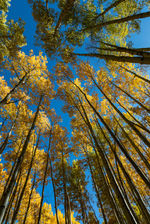Colorado
Beautiful Colorado, the 'Centennial State'
In October 2019, I joined Joe Cornish, Antony Spencer and Justin Resnik on a Lightandland organised tour of the Rocky Mountain state of Colorado to capture the fall colours, particularly the Aspen.
The Aspen is worth a special mention. Aspen trees are native to cold regions with cool summers in the Northern Hemisphere, extending south at high-altitude areas such as this. They are medium-sized deciduous trees reaching 15–30 m tall and typically grow in environments that are otherwise dominated by coniferous tree species and often lacking other large deciduous trees. Aspens have evolved several adaptations that aid their survival in such harsh environments. One is the flattened leaf, which reduces aerodynamic drag during high wind and decreases the likelihood of branch damage. Dropping leaves in the winter also helps to prevent damage from heavy winter snow. The bark is photosynthetic, meaning that growth is still possible after the leaves have dropped. Aspens are aided by the rhizomatic nature of their root systems. Most aspens grow in large clonal colonies, derived from a single seedling, and spread by means of root suckers; new stems in the colony may appear at up to 30–40 m from the parent tree. Each individual tree can live for 40–150 years above ground, but the root system of the colony is very long-lived, in some cases for thousands of years, sending up new trunks as the older trunks die off above ground. One such colony in Utah is estimated to be 80,000 years old. Some colonies become very large with time, spreading about 1 m per year, eventually covering many hectares. They are able to survive forest fires, because the roots are below the heat of the fire, and new sprouts appear after the fire burns out. Fire indirectly benefits aspen trees, since it allows the saplings to flourish in open sunlight in the burned landscape, devoid of other competing tree species. Some photos here also include Cottonwood and oak, as well as the coniferous pine, spruce and fir.
This tour took us from Denver to Snowmass, Crested Butte, Telluride, Ridgway and back home via Breckenridge. These towns are mostly former mining communities but, although mining continues in the mountains, these days they have adapted to tourism: skiing, hiking and camping.
Cloudless, intensely sunny, warm days were not the best for photography. But, in the last few days, following the seasons first snowfall and a sharp drop in temperature, we had a good time in the winter light. With the temperature drop, the leaves came showering out of the trees and within days, the fall will be over and the ski season will start. Enjoy.
























